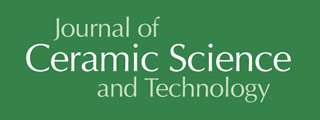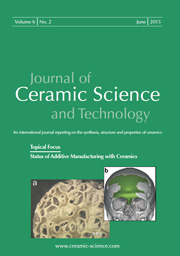Articles
All articles | Recent articles
Structuring of LTCC Substrates by a Combination of Pressure-Assisted Sintering and Hot Embossing
B. Brandt, T. Rabe
BAM Federal Institute for Materials Research and Testing, Division 5.5 – Advanced Technical Ceramics, Unter den Eichen 44 – 46, D-12203 Berlin, Germany
received September 1, 2015, received in revised form October 21, 2015, accepted November 17, 2015
Vol. 6, No. 4, Pages 273-278 DOI: 10.4416/JCST2015-00051
Abstract
A novel technology for structuring low-temperature co-fired ceramic (LTCC) surfaces is introduced. The commercial LTCC Ceramtape GC was shaped in a zero-shrinkage process by embossing a glass-like carbon mold into the softened LTCC during pressure-assisted sintering. Diverse raised and lowered structures including rings, grids, and characters were fabricated. It was found that de-airing of mold cavities is crucial for the molding of embossments. De-airing is possible through pore channels in the LTCC if embossing is performed at intermediate temperatures. The influence of LTCC viscosity on the mold filling behavior during the formation of raised structures is discussed. For accurate molding and proper densification of the LTCC, hot embossing with 0.41 MPa at 775 °C and subsequent heating under load to 850 °C is proposed. Embossing of precise, 40-µm-deep circular cavities and 50-µm-high raised bars and characters is demonstrated. Thereby, the high potential of the hot-embossing process for micro-patterning of LTCC is illustrated.
![]() Download Full Article (PDF)
Download Full Article (PDF)
Keywords
Low-temperature co-fired ceramics, pressure-assisted sintering, glassy carbon, hot embossing, structuring
References
1. Golonka, L.J.: Technology and applications of Low Temperature Cofired Ceramic (LTCC) based sensors and microsystems, B. Pol. Acad. Sci., 54, [2], 221 – 231 (2006).
2. Imanaka, Y.: Multilayered Low Temperature Cofired Ceramics (LTCC) technology, Springer, New York, 2005.
3. Khoong, L.E., Tan, Y.M., Lam, Y.C: Overview on fabrication of three-dimensional structures in multi-layer ceramic substrate, J. Eur. Ceram. Soc., 30, [10], 1973 – 1987, (2010).
4. Malecha, K., Golonka, L.J.: Three-dimensional structuration of zero-shrinkage LTCC ceramics for microfluidic applications, Microelectron. Reliab., 49, [6], 585 – 591, (2009).
5. Nowak, K.M., Baker, H.J., Hall, D.R.: Cold processing of green state LTCC with a CO2 laser. Appl. Phys. A – Mater., 84, [3], 267 – 270, (2006).
6. Rabe, T., Kuchenbecker, P., Schulz, B., Schmidt, M.: Hot embossing: An alternative method to produce cavities in ceramic multilayer, Int. J. Appl. Ceram. Tec., 4, [1], 38 – 46, (2007).
7. Shan, X.C., Soh, Y.C, Shi, C.W.P., Tay, C.K., Chua, K.M., Lu, C.W.: Large-area patterning of multilayered green ceramic substrates using micro roller embossing, J. Micromech. Microeng., 18, [6], (2008).
8. Harris, P.J.F.: Fullerene-related structure of commercial glassy carbons, Philos. Mag., 84, [29], 3159 – 3167, (2004).
9. Bonderer, L.J., Chen, P.W., Kocher, P., Gauckler, L.J.: Free-standing ultrathin ceramic foils, J.Am. Ceram, Soc., 93, [11], 3624 – 3631, (2010).
10. Youn, S.W., Takahashi, M., Goto, H., Maeda, R.: Microstructuring of glassy carbon mold for glass embossing – comparison of focused ion beam, nano/femtosecond-pulsed laser and mechanical machining, Microelectron. Eng., 83, [11 – 12], 2482 – 2492, (2006).
11. Youn, S.W., Ueno, A., Takahashi, M., Maeda, R.: A process of glassy carbon etching without the micro masking effect for the fabrication of a mold with a high-quality surface, J. Micromech. Microeng., 19, [12], (2009).
12. Takahashi, M., Sugimoto, K., Maeda, R.: Nanoimprint of glass materials with glassy carbon molds fabricated by focused-ion-beam etching, Jpn, J. Appl. Phys. 1, 44, [7B], 5600 – 5605, (2005).
13. Brandt, B., Gemeinert, M., Rabe, T., Bolte, J.: Low-Temperature Co-Fired Ceramic substrates for high-performance strain gauges, J. Micromech. Microeng., 10, [3], 413 – 420, (2013).
14. Brandt, B., Rabe, T.: Surface characteristics of LTCC substrates fabricated by pressure-assisted sintering, Journal of Microelectronics and Electronic Packaging, 10, [4], 144 – 159, (2013).
15. Ollagnier, J.B., Guillon, O., Rödel, J.: Effect of anisotropic microstructure on the viscous properties of an LTCC material, J. Am. Ceram. Soc., 90, [12], 3846 – 3851, (2007).
16. Kemethmueller, S., Hagymasi, M., Stiegelschmitt, A., Roosen, A.: Viscous flow as the driving force for the densification of low-temperature co-fired ceramics, J. Am. Ceram. Soc., 90, [1], 64 – 70, (2007).
17. Tramosljika, D.: Sintering behavior of a low-temperature sintering ceramic and the influence of silver on its sintering behavior, (in German), Dissertation, University Stuttgart, Germany (2007).
18. Mohanram, A., Messing, G.L., Green, D.J.: Densification and sintering viscosity of low-temperature co-fired ceramics, J. Am. Ceram. Soc., 88, [10], 2681 – 2689, (2005).
19. Xie, R.J., Zuo, R.Z., Aulach, E., Mackens, U., Hirosaki, N., Roedel, H.: Uniaxial viscosity of low-temperature cofired ceramics (LTCC) powder compacts determined by loading dilatometry, J. Eur. Ceram. Soc., 25, [4], 417 – 424, (2005).
Copyright
Göller Verlag GmbH


